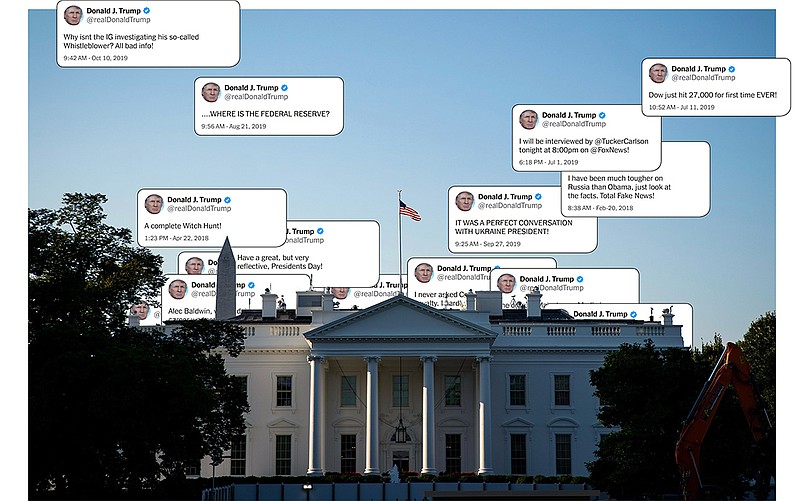The president of the United States lives in a dark and dangerous virtual world - the Twitter world of conspiracy mongers, racists and spies.
That is the assessment of a New York Times examination of Donald Trump's Twitter habits in a story published Saturday at NYtimes.com.
It might be one thing, if the president were just any odd person whose Twitter account numbers 65.8 million followers and receives 1,000 tweets per minute. But he's not just any odd person. He's the president of the United States, and that means he's the one user among 126 million daily Twitter users who can influence global policy and markets in 280 characters.
This really gets scary when you look at The Times' deep dive into Trump's more than 11,000 tweets since he took office nearly three years ago.
In almost half of Trump's tweets - 5,889 - he has attacked someone or something - usually Democrats, news organizations, minority groups and investigations, especially the Russia and impeachment inquiries.
But perhaps the scariest finding of all is his exposure to - and all-to-frequent spreading of - conspiracy theories, many of which come to him from the 47 accounts that Trump "follows." Those accounts - mainly family, celebrities, Fox News hosts or Republican politicians - make up his curated feed. A number of those people, in turn, follow Twitter accounts that promote QAnon, express anti-Islam attitudes or espouse white nationalist views.
Some of those tweeters, along with the random tweets tagged to him, shape - or perhaps more accurately misshape - his thinking: In 1,710 of his tweets - more than 15% of all his missives - he promoted and retweeted conspiracy theories that found their way into his head via Twitter.
The Times writes:
"Tweets that tag his handle, @realDonaldTrump, can be found with hashtags like #HitlerDidNothingWrong, #IslamIsSatanism and #WhiteGenocide. While filters can block offensive material, the president clearly sees some of it, because he dips into the frothing currents and serves up noxious bits to the rest of the world.
By retweeting suspect accounts, seemingly without regard for their identity or motives, he has lent credibility to white nationalists, anti-Muslim bigots and obscure QAnon adherents like VB Nationalist, an anonymous account that has promoted a hoax about top Democrats worshiping the Devil and engaging in child sex trafficking.
... The result, including new data analysis and previously unreported details, offers the most comprehensive view yet of a virtual world in which the president spends significant time mingling with extremists, impostors and spies."
For instance, Trump in September 2017 retweeted what looked like a Tennessee Republican group's tweet of adoration for him. In fact, the account @10_gop, was run by Russian intelligence and was later banned by Twitter.
Research from The Times and other groups indicates that a third or more of Trump's Twitter followers may simply be automated bots, fake accounts or inactive. But the bots, of course, do more than just fool Trump. They also add to the giving and sharing of Trump's conspiracy theories and attacks to other more normal and non-Trump-following Twitter users - like your uncle or your grandmother or you.
How dangerous is it that the president engages in this behavior? Clint Watts, a former FBI agent and a cybersecurity expert who studies propaganda campaigns on social media, says it's very dangerous - if for no other reason than the clearly enormous amount of time the president spends on Twitter. "It gives you [extremists, impostors and spies] an amazing opportunity to game the president," Watts told The Times.
It's not hyperbole. After all, this is the president who believes the conspiracy theorists rather than the 17 U.S. agencies that told him Russia interfered with our 2016 presidential election.
Equally dangerous is how the media - "fake news" in many of Trump's tweets - broadens Trump delusional missives well beyond the 22 percent of Americans who use Twitter.
When Trump took took office, he tweeted about nine times a day. In the past three months he has tripled that rate, treating his phone like "a digital howitzer that he relished firing," according to The Times. In addition to attacks, Trump has used Twitter to hire and fire aides, to increase tariffs and deepen tensions between countries, to undo years of American domestic and foreign policy.
"Boom. I press it," Trump said of his Twitter use in a White House conference attended by conservative social media personalities, "and, within two seconds, 'We have breaking news.'"
And, unfortunately, well we should. Trump is not just any Twitter user. When he taps out threats that rogue nation North Korea might not 'be around much longer," it's news. His tweets also have had to take on more currency since, by White House design, the traditional daily on-camera press briefings from the White House have stopped.
The good news is that the media has more than 280 characters, and most Americans are seeing the senselessness of Trump's tiring bubble wrap.
More good news is that, according to the New York Times analysis and Pew Research, fewer than one-fifth of Trump's Twitter followers are voting-age Americans.
